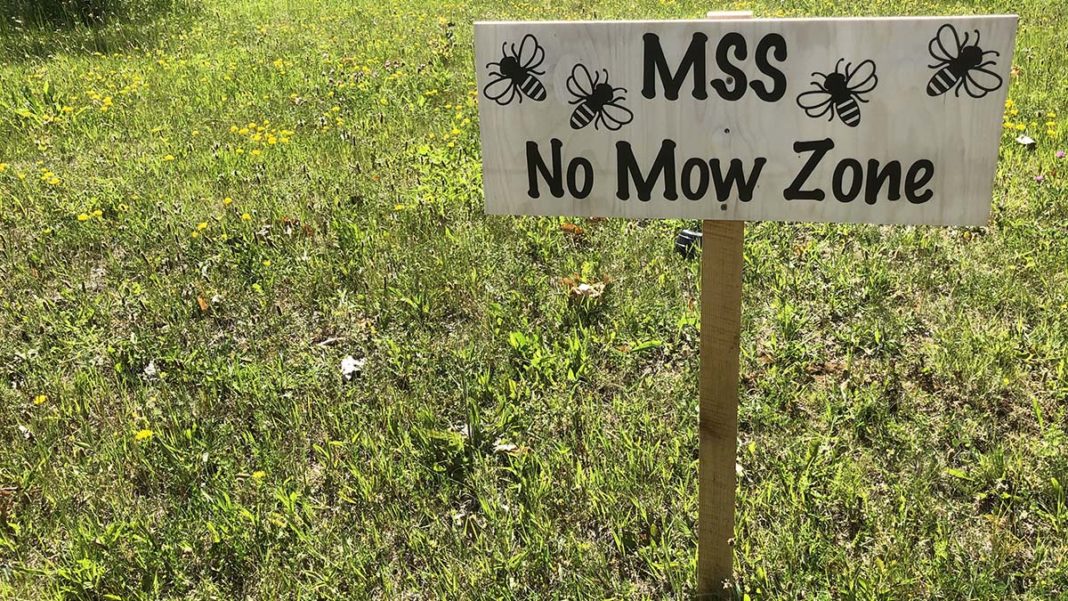M’CHIGEENG—Students and staff at Manitoulin Secondary School will be greeted by a new sign located on a small square of lawn as they return to classes this week. The sign proudly announces a new ‘no mow’ zone at the school, courtesy of members of the Share/Go Green team. The roughly 200 square metre plot is visible as you drive towards the school and is one of the ongoing activities that has helped earn the school platinum certification in the EcoSchools Canada certification program.
No mow zones are part of a recent trend towards allowing grassy areas or lawns to revert to more natural meadows and pollinator habitats by not mowing. “It’s just sort of a simple thing to do,” said Chris Theijsmeijer, a teacher at MSS and one of three staff members that were involved in the no mow project (the others being Yana Bauer and Paul Becks). “You set up the zone and basically, you do less work. You’re saving energy because you’re not mowing it continuously, but there are other benefits to it as well.”
“The no mow zone supplies a small environment for insects like fireflies, dragonflies and many other insects,” said Ezra Diebolt, who along with fellow student and eco-hero Anika Smith, were instrumental in the development of this project. “Unmowed natural areas can be inviting to more than just insects as well. Sometimes, small animals go through said unmowed areas to find food, and because of the mini environment, they can actually find said food. That’s how something as small as leaving an area unmowed can help the environment, at least a little bit.”
To create the no mow zone, the group had to first find a good space, one that would still allow mowers to easily cut the rest of the grass. Once a space was decided on, they had to mark it off. That was largely the extent of effort required. Some of the students on the green team were also in tech class this year, Mr. Theijsmeijer said. “They made some nice signs to announce it so people realize it’s not just us being lazy but there’s an actual purpose to the no mow zone.”
There were wildflower seeds leftover from an Earth Day event that had been donated by Manitoulin Transport, so those were thrown out into the zone as well. “We thought that was a perfect use for them,” he added. “Not many of them are coming up yet.”
Long term plans include development of the area into a learning activity zone. They’re hoping to add some native species so they can talk about some of the things that you wouldn’t normally see in a lawn, Mr. Theijsmeijer said. “Sweetgrass, for example. Paul Becks has been involved in coming up with the design of what we might actually be putting there. We’re going to be looking at putting in different species, and also providing the opportunity for different insects that may be able to come through the zone.”
Mr. Becks works with the school apiary and while it’s not likely the bees will be located in the no mow zone, there will still be a learning and discussion point for observing the flowers that will grow there and how they attract the bees and other pollinators. A small stream borders the no mow zone so the area should have good drainage, allowing for more creative plantings that aren’t just grass. “Right now it’s not very exciting, but we’re hoping that over the years it will develop into a more diverse ecosystem,” Mr. Theijsmeijer said.
It was the end of May when he travelled with the tennis team to the provincial championships. “I think the whole City of Toronto had decided on doing No Mow May, which is also a thing, to help promote biodiversity in the beginning of spring,” said Mr. Theijsmeijer. “We saw when we were down there all the grass around the 401 on-ramps, off-ramps, along the sides of streets and even parks, hadn’t been mowed yet. They’re a few weeks ahead of us in growth so it was like a foot-long grass through a lot of spaces. The kids were very surprised to see that. It’s something that’s sort of gaining popularity in society now. Having a clean-cut lawn is not always the most environmentally friendly option.”




